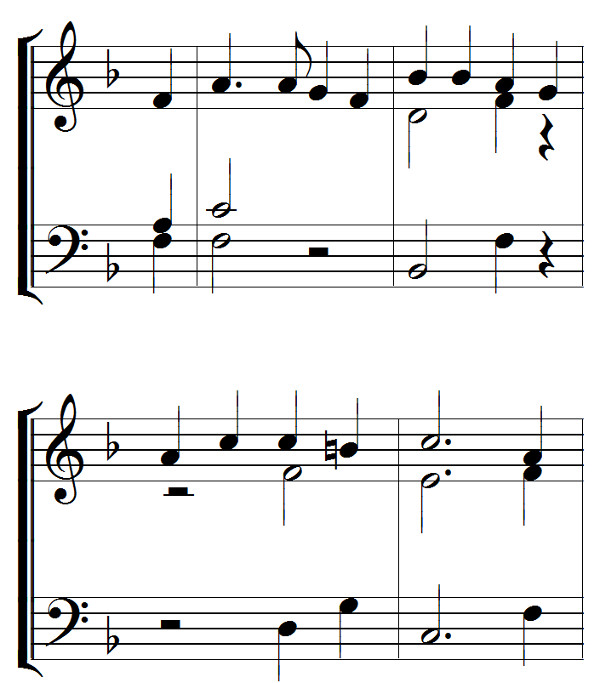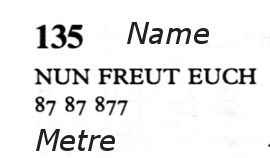Simplified Hymns Tunes
Playing These Arrangements
These arrangements consist, basically, of melody and bass with middle notes added to fill-out the harmony. The middle notes are not supposed to make a coherent middle part, so unnecessary rests have been omitted
and the vertical arrangement of the notes tell you what should be played together.
They can be used in various ways:
- Played as written;
- Played as written, but using any hand convenient to play the middle notes. These arrangements suit my hands, but the division of notes won't be the best for everyone.
- Played as written, but placing the middle notes in any convenient octave.
- Played as written, but omitting any of the middle notes that are hard to reach
- Played melody only, but the accompanying chords being added at the beginning and ends of text lines. For instance, While Shepherds Watched could be played like this:

Also, if more convenient in the accompanying parts, tied notes may be repeated or repeated notes tied at will.
The main thing is that the melody should flow regularly and without unexpected pauses - everything else being subservient to this.
You can find out more about good and bad hymn playing, management of the organ and selecting stops, and other tips HERE.
RETURN TO:
Top
List of Hymns
Organists Online
Browser Searches
Browser searches look through the document you have on screen, without digging deeper into hidden code or back to the server of origin. Such searches are useful for quickly finding something in a mass of text.
Most browsers have a key-stroke activated search facility as follows:
In Windows
Chrome = CTRL + F
Firefox =
CTRL + F
Microsoft Edge = CTRL + F
and so on.
On a Mac they will be different, but the principle is the same.
As the list of simplfied hymns grows, it will take longer to scroll down to a specific hymn, or trawl through the list looking for a tune name, or metre. A browser search will be much quicker.
RETURN TO:
Top
List of Hymns
Organists Online
In the next two sections, we will be talking about Name and Metre. These are often found near the hymn number:

The name in this example is Nun Freut Euch, and the metre is 87 87 887, which would be written as 8.7.8.7.8.8.7 in these pages.
Metre
The metre of a hymn is a codified description of how many syllables it has in each line. For instance:
There was a young girl in the choir,
(8 syllables)
Whose voice arose higher and higher,
(9 syllables)
'Til one Sunday night
(5 syllables)
It just vanished from sight,
(6 syllables)
And they found it next day on the spire.
(9 syllables)
The metre of this would be codified as 8.8.9.6.9.
Similarly:
There are holes in the sky
(6 syllables)
Where the rain comes in,
(5 syllables)
But the holes are small
(5 syllables)
So the rain is thin.
(5 syllables)
would have a codified metre of 6.5.5.5.
Some metres are so common that they are denoted by an acronym:
Common Metre - CM = 8.6.8.6
Short Metre - SM = 6.6.8.6
Long Metre - LM = 8.8.8.8
Double Common Metre - DCM = 8.6.8.6.8.6.8.6
Double Short Metre - DSM = 6.6.8.6.6.6.8.6
Double Long Metre - DLM = 8.8.8.8.8.8.8.8
Most hymn books state the metre of a hymn tune. By matching metres, it's possible to select alternative tunes for any given hymn.
Beware!! Beware!!
Some hymns have similar codified metres, but the accentuation of the lines is different. Forty Days and Forty nights,
and A Brighter Dawn is Breaking both have a metre of 7.7.7.7, but one accents thus:
For-ty days and for-ty nights.
and the other is
A bright-er dawn is break-ing.
If you are changing the tune for a hymn, always check that not only the metre is the same, but the accentuation pattern is also correct.
RETURN TO:
Top
List of Hymns
Organists Online
Tune Name
It's a characteristic of English hymnody that many tunes are given names, such as Holyrood or Hyfrydol, which are stated beside the hymn number. If you look, for instance, in the German
Evangelisches Gesangbuch, the tunes are - well - just tunes. There's no way of quickly identifying any one specific tune.
The English system may seem quaint, but it's particulary useful if one tune is used for several different hymns. There is a close connection between
Horsley and There is a Green Hill, so naming the hymn pretty well identifies the melody. On the other hand, Alleluia, Sing to Jesus is set to Hyfrydol in many hymn books, and to Alleluia
in others - so, naming the hymn does not specify the tune. Similarly, the tune Aurelia is set to three different hymns in Catholic Hymns Old and New. If you are looking for a simplfied accompaniment on these pages, but can't find the hymn you want, searching for the melody
by name may be successful.
RETURN TO:
Top
List of Hymns
Organists Online
Hymn Title
If you are searching for a hymn by title or first line, allow for variation in punctuation. It's possible that missing or added commas could frustrate a search. For instance:
A search for
Praise My Soul, the King of Heaven,
won't find
Praise, My Soul, the King of Heaven.
So, if a search is unsuccessful, try again adding/omitting a comma or two.
Luckily, most browser searches aren't case-sensitive, so King, king, Lord, lord, etc won't make any difference.
RETURN TO:
Top
List of Hymns
Organists Online